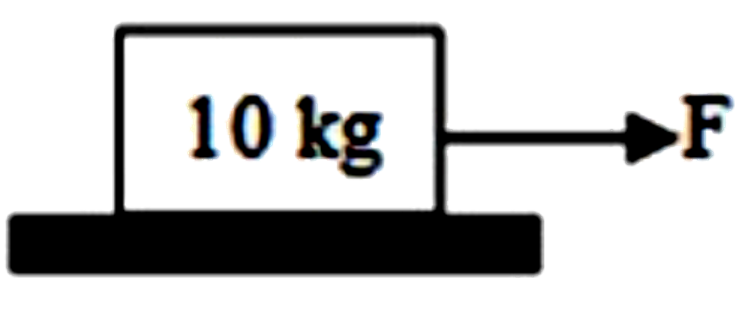A body of mass 0.40 kg moving initially with a constant speed of 10m/s to the north is subjected to a constant force of 8.0 N directed towards the south for 30 s Take the instant the force is applied to be t = 0, and the position of the particle at that time to be x = 0, predict its position at t=−5s,25s,100s ?
To solve the problem step by step, we will analyze the motion of the body under the influence of the applied force and calculate its position at the specified times.
Given Data:
- Mass of the body, m=0.40kg
- Initial speed, u=10m/s (to the north)
- Force applied, F=8.0N (to the south)
- Time duration of force application, t=30s
- Initial position, x(0)=0
Step 1: Determine the acceleration due to the force
The acceleration a can be calculated using Newton's second law:
a=Fm=−8.0N0.40kg=−20m/s2
(Note: The acceleration is negative because the force is directed south, which we have taken as the negative direction.)
Step 2: Calculate the position at t=−5s
Since no force is applied before t=0, the body moves with a constant speed.
x(−5)=u⋅t=10m/s⋅(−5s)=−50m
Step 3: Calculate the position at t=25s
For t=25s, the force has been applied for 25s (which is within the 30 seconds of force application). We can use the equation of motion:
x(t)=ut+12at2
Substituting the values:
x(25)=10⋅25+12⋅(−20)⋅(25)2
Calculating:
x(25)=250+12⋅(−20)⋅625
x(25)=250−6250=−6000m
Step 4: Calculate the position at t=100s
For t=100s, the force has only been applied for the first 30 seconds. After that, the body moves with a constant velocity (which we need to calculate first).
Calculate the velocity at t=30s:
Using the equation:
v=u+at
v=10+(−20)⋅30=10−600=−590m/s
Calculate the displacement for the first 30 seconds:
x1=ut+12at2
x1=10⋅30+12⋅(−20)⋅(30)2
Calculating:
x1=300−9000=−8700m
Calculate the displacement from t=30s to t=100s:
The time duration is 100−30=70s:
x2=v⋅t=−590⋅70=−41300m
Total position at t=100s:
x(100)=x1+x2=−8700+(−41300)=−50000m
Summary of Results:
- Position at t=−5s: x(−5)=−50m
- Position at t=25s: x(25)=−6000m
- Position at t=100s: x(100)=−50000m
- Mass of the body, m=0.40kg
- Initial speed, u=10m/s (to the north)
- Force applied, F=8.0N (to the south)
- Time duration of force application, t=30s
- Initial position, x(0)=0
The acceleration a can be calculated using Newton's second law:
a=Fm=−8.0N0.40kg=−20m/s2
(Note: The acceleration is negative because the force is directed south, which we have taken as the negative direction.)
Since no force is applied before t=0, the body moves with a constant speed.
x(−5)=u⋅t=10m/s⋅(−5s)=−50m
For t=25s, the force has been applied for 25s (which is within the 30 seconds of force application). We can use the equation of motion:
x(t)=ut+12at2
Substituting the values:
x(25)=10⋅25+12⋅(−20)⋅(25)2
Calculating:
x(25)=250+12⋅(−20)⋅625
x(25)=250−6250=−6000m
For t=100s, the force has only been applied for the first 30 seconds. After that, the body moves with a constant velocity (which we need to calculate first).
Using the equation:
v=u+at
v=10+(−20)⋅30=10−600=−590m/s
x1=ut+12at2
x1=10⋅30+12⋅(−20)⋅(30)2
Calculating:
x1=300−9000=−8700m
The time duration is 100−30=70s:
x2=v⋅t=−590⋅70=−41300m
x(100)=x1+x2=−8700+(−41300)=−50000m
- Position at t=−5s: x(−5)=−50m
- Position at t=25s: x(25)=−6000m
- Position at t=100s: x(100)=−50000m
Topper's Solved these Questions
Similar Questions
A bolck of mass 10kg is moving in x-direction with a constant speed of 10m/s. it is subjected to a retardeng force F=−0.1xJ/m. During its travel from x=20m to x=30m. Its final kinetic energy will be .
View SolutionA block of mass 10kg is moving in x-direction with a constant speed of 10m/s. it is subjected to a retarding force F=−0.1xJ/m. During its travel from x=20m to x=30m. Its final kinetic energy will be .
View Solution
Knowledge Check
A block of mass 10kg is moving in x-direction with a constant speed of 10m/s. it is subjected to a retarding force F=−0.1xJ/m. During its travel from x=20m to x=30m. Its final kinetic energy will be .
A250 JB275 JC450 JD475 JA body of mass 0.4kg starting at origin at t=0 with a speed of 10ms−1 in the positive x-axis direction is subjected to a constant F=8 N towards negative x-axis. The position of body after 25s is
A−6000mB−8000mC+4000mD+7000m
A block of mass 20 kg is moving in x-direction with a constant speed of 10 ms−1. It is subjected to a retarding force F=(−0.1x)N during its travel from x=20 m to x=30 m. Its final kinetic energy will be
View SolutionA block of mass 20 kg is moving in x-direction with a constant speed of 10 ms−1. It is subjected to a retarding force F=(−0.1x)N during its travel from x=20 m to x=30 m. Its final kinetic energy will be
View SolutionA particle is kept at rest at the origin. A constant force →F starts acting on it at t=0. Find the speed of the particle at time t.
View SolutionA force F=2t2 is applied to the cart of mass 10 Kg, initially at rest. The speed of the cart at t = 5 s is -

View SolutionA block of mass 2.00 kg moving at a speed of 10.0 m/s accelerates at 3.0 ms2 for 5.00 s. Compute its final kinetic enegy.
View SolutionA particle movesin the X-Y plane with a constasnt acceleration of 1.5ms2 in the direction making an angle of 370 with the X-axis.At t=0 the particle is at the orign and its velocity is 8.0 m/s along the X-axis. Find the velocity and the position of the particle at t=4.0 s.

View Solution
